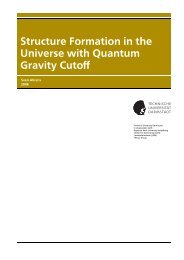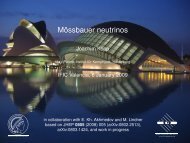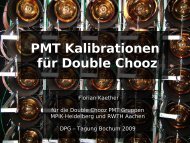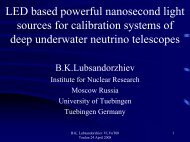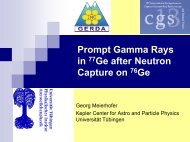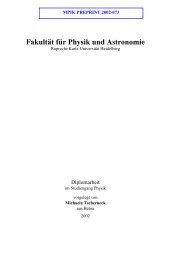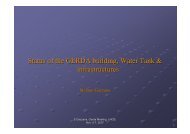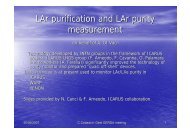Natural convection in enclosures with localized heating from below ...
Natural convection in enclosures with localized heating from below ...
Natural convection in enclosures with localized heating from below ...
You also want an ePaper? Increase the reach of your titles
YUMPU automatically turns print PDFs into web optimized ePapers that Google loves.
forces are dom<strong>in</strong>ant over the buoyancy force. As it can be seen <strong>from</strong> the figure,<br />
isotherms deviate slightly <strong>from</strong> a diagonally symmetric structure, which is the<br />
conduction solution (Ra = 0). This leads the conduction to be dom<strong>in</strong>ant heat<br />
transfer mechanism <strong>in</strong>side the enclosure. With <strong>in</strong>creas<strong>in</strong>g Rayleigh number, the<br />
<strong>in</strong>tensity of the recirculation <strong>in</strong>side the enclosure <strong>in</strong>creases and the cores of the<br />
cells move upward. At Ra =10 4 , isotherms deviates <strong>from</strong> the diagonally<br />
symmetric structure and conduction and advection modes of heat transfer are<br />
<strong>in</strong> a comparable level. Beyond Ra = 10 4 , the distortion of the isotherms<br />
<strong>in</strong>creases more and more and the advection takes the revenge, becom<strong>in</strong>g the<br />
dom<strong>in</strong>ant mode of heat transfer. At Ra = 10 5 , the formation of thermal<br />
boundary layers can be observed due to <strong>in</strong>creased recirculation <strong>in</strong>tensity. At Ra<br />
=10 6 , the thermal boundary layers become th<strong>in</strong>ner caus<strong>in</strong>g <strong>in</strong>creased energy<br />
transport. In addition, isotherms become stratified and the degree of<br />
stratification <strong>in</strong>creases <strong>with</strong> <strong>in</strong>creas<strong>in</strong>g Ra. Streaml<strong>in</strong>es and isotherms for =4/<br />
5 at different Rayleigh numbers are seen <strong>in</strong> Figure 3. The flow fields are nearly<br />
identical to those of = 1/5 for each Rayleigh number. However, the isotherms<br />
are effected by the <strong>in</strong>creas<strong>in</strong>g , as expected. S<strong>in</strong>ce the heated part of lower<br />
surface is larger than that of = 1/5, the heat<strong>in</strong>g effect at this case is much more<br />
sensible for the same values of Rayleigh numbers. For a fixed Ra, <strong>with</strong><br />
<strong>in</strong>creas<strong>in</strong>g , the flow field rema<strong>in</strong>s almost the same, while the temperature<br />
fields changes becom<strong>in</strong>g more stratified for larger values of Ra.<br />
Ow<strong>in</strong>g to the symmetry <strong>in</strong> the temperature field, heat transfer is<br />
L l<br />
symmetrical <strong>with</strong> respect to mid-length (x = L/2), hence Nu x ˆ 2 =<br />
Nu x ˆ L‡l<br />
2 . As an illustrative example, Figure 4 shows the variation of Nu<br />
along the heated part of the lower wall for = 2/5 for various Rayleigh<br />
numbers. The higher Ra means more heat <strong>in</strong>put, and as a result, more heat is<br />
added to the fluid to <strong>in</strong>tensify the fluid <strong>convection</strong>. The <strong>in</strong>tensified fluid<br />
<strong>convection</strong>, <strong>in</strong> turn, enables more heat to be received by the fluid pack through<br />
convective heat transfer. The most strik<strong>in</strong>g feature of this figure is the<br />
m<strong>in</strong>imum at heat transfer <strong>in</strong> X = 1/2. This m<strong>in</strong>imum orig<strong>in</strong>ates <strong>from</strong> the<br />
symmetrical boundary conditions applied <strong>in</strong> the vertical direction. The dualcell<br />
structure prohibits direct convective transfer between these two cells. Each<br />
cell behaves like an <strong>in</strong>sulator prevent<strong>in</strong>g the fluid pack <strong>from</strong> com<strong>in</strong>g <strong>in</strong>to<br />
contact <strong>with</strong> opposite cold wall.<br />
Plots of the average Nusselt number on the heated part of the lower wall as a<br />
function of Ra and are shown <strong>in</strong> Figure 5. For a fixed , <strong>in</strong>creas<strong>in</strong>g Ra<br />
enhances <strong>convection</strong>. In addition, <strong>in</strong>creas<strong>in</strong>g for a fixed Ra results <strong>in</strong> an<br />
<strong>in</strong>crease at Nu, which is more significant for high Ra values. These results can<br />
be clearly expla<strong>in</strong>ed under the views of the isotherms given <strong>in</strong> Figure 2 and 3.<br />
Conclusion<br />
In this <strong>in</strong>vestigation, the results of a numerical study of buoyancy-<strong>in</strong>duced flow<br />
and heat transfer <strong>in</strong> a two-dimensional square enclosure <strong>with</strong> <strong>localized</strong> heat<strong>in</strong>g<br />
<strong>from</strong> <strong>below</strong> and symmetrical cool<strong>in</strong>g <strong>from</strong> the sides are presented. The ma<strong>in</strong><br />
<strong>Natural</strong><br />
<strong>convection</strong> <strong>in</strong><br />
<strong>enclosures</strong><br />
527



